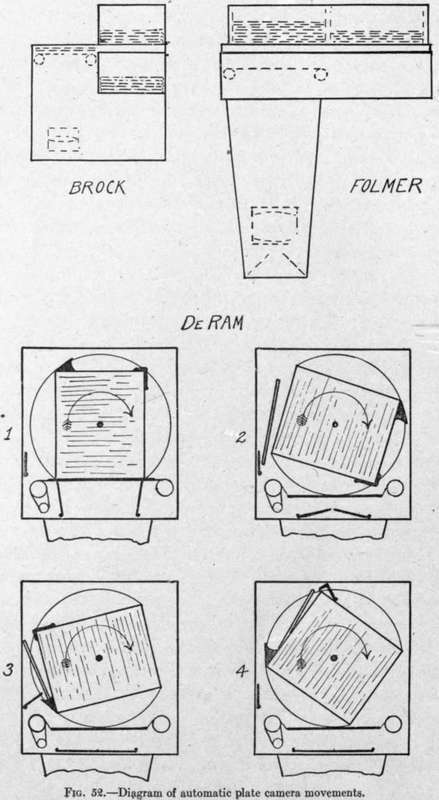The American Model Deram Camera
Description
This section is from the book "Airplane Photography", by Herbert E. Ives. Also available from Amazon: Airplane photography.
The American Model Deram Camera
The rotary changing box devised by Lieutenant deRam of the French army and incorporated in his entirely automatic plate camera, has been adapted by the American Air Service to a very successful semi-automatic camera. Fig. 52 shows the principle of this changing box. The pile of fifty plates, each in its sheath, is carried in a rectangular box open at top and bottom. The lower plate next the focal-plane shutter is first exposed; the pile then rotates about a horizontal axis through a complete turn. When the exposed plate arrives in a vertical position it is allowed to drop off, by the opening of cam actuated fingers, and lodges against the side of the enclosing camera box proper. Still further along in the cycle the plate is thrown off from its lodging place into a "scoop" on the top of the rotating container and laid on the top of the plate pile. Meanwhile the curtain of the focal-plane shutter winds up, at the same time that it is depressed out of the way of the revolving plate container. Although the plate changing operation depends on gravity, it nevertheless functions satisfactorily up to 30 degrees from the vertical.
The shutter in this model is the variable-aperture fixed-tension type, adjusted by pivoted idlers (Fig. 28). In the exposing position it runs within three millimeters of the plate surface, and is therefore of high efficiency for all openings. Capping during the operation of setting is performed by flaps at the bottom of the camera body. Interchangeable cones are supplied for lenses of various focal lengths.
For hand operation the changing box is turned over by means of a handle, which rotates four times for the complete cycle (Fig. 90). For semi-automatic operation an additional mechanism is provided on the side of the rectangular camera body, copied with some necessary modifications after the L camera power drive. From the observer's standpoint the operation of the whole camera is the same as in the L camera, with the important exception that power operation in no way interferes with hand operation. Indeed, the hand can help out if the power flags or fails.

This camera is most satisfactorily driven by a 12 volt 1/10 HP electric motor working through a flexible shaft attached to a swivel connection at the front of the semiautomatic drive box. A change once every four to five seconds is possible, but greater speed is apt to throw the changing plate too violently for safety.
The chief practical objection to this camera is its bulk. Its great height makes it impractical for many planes. Its weight of nearly a hundred pounds is a formidable load for a plane to carry, but this is no more and probably less than that of any other camera when taken up with the same number of plates in magazines. The price paid for economizing in magazine weight is that the whole camera body, excluding the lens cone, must be carried to and from the plane for'both loading and unloading.
Continue to:
- prev: The English Lb And Bm Cameras
- Table of Contents
- next: Chapter X. Automatic Aerial Plate Cameras. General Characteristics
Tags
camera, lens, airplane, aerial, film, exposure, photography, maps, birdseye
